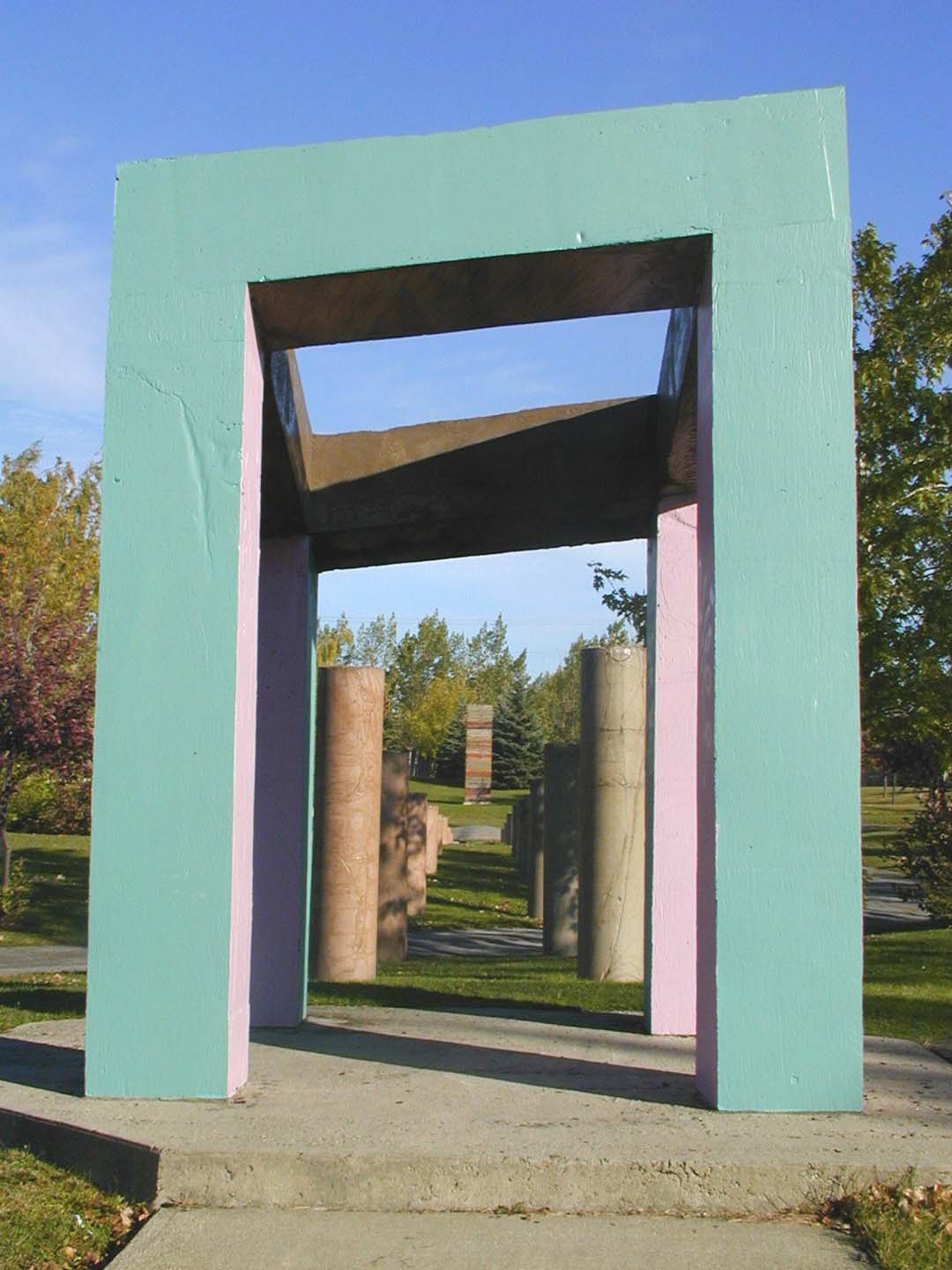Tatiana Démidoff-Séguin
Place du Temple
1990
Presentation of the artwork
The monumental sculpture Place du temple is presented in the park as contemporary ruins of an imagined time. A pavilion composed of four pillars and four lintels, painted blue and pink, stands in an octagonal space. Behind, a series of pilings, arranged in decreasing height until one is completely submerged in water, suggests a form of perspective the vanishing point of which would be the immense monolith made of layers of coloured cement, situated on an island.Although the artwork seems to be imposed on the landscape, viewers are free to move in the space seeking traces of timeless memory or senses. Combining aspects of archaeological site and place of worship, the sculptural environment offers visitors a place for contemplation and meditation.
Faithful to her artistic approach, here the artist presents, in a modern material, an architecture stripped of its usual function and whose symbolism, rich but indistinct, encourages reflection.
Associated events
The work was created during Sculpture: Séduction 90, an event that took place in 16 Montréal Urban Community parks from 15 June to 30 September 1990. Organized by the Conseil de la sculpture du Québec, its goal was to present “a permanent itinerary of large-format sculptures integrated with the environment of municipal parks.”
Tatiana Démidoff-Séguin
Tatiana Démidoff-Séguin (1935–2006) was a Québec painter and sculptor of Russian ancestry, born in Algeria. She received a classical education in Algiers and studied art in Paris before moving to Québec in 1962. Co-founder of the magazine Espace, she became an important figure in Québec sculpture.
Démidoff-Séguin participated in a number of symposiums and left 15 works of public art, in Quebec and abroad, including La colonne du temps (1991) in Combs-la-Ville, France, and Passage (2003) in Rivière-du-Loup, Québec.
Démidoff-Séguin participated in a number of symposiums and left 15 works of public art, in Quebec and abroad, including La colonne du temps (1991) in Combs-la-Ville, France, and Passage (2003) in Rivière-du-Loup, Québec.
Awards and honours
- Médaille de Rayonnement culturel, Renaissance française, ????
Presentation of the artwork
The monumental sculpture Place du temple is presented in the park as contemporary ruins of an imagined time. A pavilion composed of four pillars and four lintels, painted blue and pink, stands in an octagonal space. Behind, a series of pilings, arranged in decreasing height until one is completely submerged in water, suggests a form of perspective the vanishing point of which would be the immense monolith made of layers of coloured cement, situated on an island.Although the artwork seems to be imposed on the landscape, viewers are free to move in the space seeking traces of timeless memory or senses. Combining aspects of archaeological site and place of worship, the sculptural environment offers visitors a place for contemplation and meditation.
Faithful to her artistic approach, here the artist presents, in a modern material, an architecture stripped of its usual function and whose symbolism, rich but indistinct, encourages reflection.
Associated events
The work was created during Sculpture: Séduction 90, an event that took place in 16 Montréal Urban Community parks from 15 June to 30 September 1990. Organized by the Conseil de la sculpture du Québec, its goal was to present “a permanent itinerary of large-format sculptures integrated with the environment of municipal parks.”
Tatiana Démidoff-Séguin
Tatiana Démidoff-Séguin (1935–2006) was a Québec painter and sculptor of Russian ancestry, born in Algeria. She received a classical education in Algiers and studied art in Paris before moving to Québec in 1962. Co-founder of the magazine Espace, she became an important figure in Québec sculpture.
Démidoff-Séguin participated in a number of symposiums and left 15 works of public art, in Quebec and abroad, including La colonne du temps (1991) in Combs-la-Ville, France, and Passage (2003) in Rivière-du-Loup, Québec.
Démidoff-Séguin participated in a number of symposiums and left 15 works of public art, in Quebec and abroad, including La colonne du temps (1991) in Combs-la-Ville, France, and Passage (2003) in Rivière-du-Loup, Québec.
Awards and honours
- Médaille de Rayonnement culturel, Renaissance française, ????




